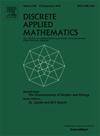The k-general d-position problem for graphs
IF 1
3区 数学
Q3 MATHEMATICS, APPLIED
引用次数: 0
Abstract
A set of vertices of a graph is said to be in general position if no three vertices from the set lie on a common shortest path. Recently Klavžar, Rall and Yero generalized this notion by defining a set of vertices to be in general -position if no three vertices from the set lie on a common shortest path of length at most . We generalize this notion further by defining a set of vertices to be in -general -position if no vertices of the set lie on a common shortest path of length at most . The -general -position number of a graph is the largest cardinality of a -general -position set. We provide upper and lower bounds on the -general -position number of graphs in terms of the -general -position number of certain kinds of subgraphs. We compute the -general -position number of finite paths and cycles. Along the way we establish that the maximally even subsets of cycles, which were introduced in Clough and Douthett’s work on music theory, provide the largest possible -general -position sets in -cycles. We generalize Klavžar and Manuel’s notion of monotone-geodesic labeling to that of -monotone-geodesic labeling in order to calculate the -general -position number of the infinite two-dimensional grid. We also prove a formula for the -general -position number of certain thin finite grids, providing a partial answer to a question asked by Klavžar, Rall and Yero.
求助全文
约1分钟内获得全文
求助全文
来源期刊

Discrete Applied Mathematics
数学-应用数学
CiteScore
2.30
自引率
9.10%
发文量
422
审稿时长
4.5 months
期刊介绍:
The aim of Discrete Applied Mathematics is to bring together research papers in different areas of algorithmic and applicable discrete mathematics as well as applications of combinatorial mathematics to informatics and various areas of science and technology. Contributions presented to the journal can be research papers, short notes, surveys, and possibly research problems. The "Communications" section will be devoted to the fastest possible publication of recent research results that are checked and recommended for publication by a member of the Editorial Board. The journal will also publish a limited number of book announcements as well as proceedings of conferences. These proceedings will be fully refereed and adhere to the normal standards of the journal.
Potential authors are advised to view the journal and the open calls-for-papers of special issues before submitting their manuscripts. Only high-quality, original work that is within the scope of the journal or the targeted special issue will be considered.
 求助内容:
求助内容: 应助结果提醒方式:
应助结果提醒方式:


